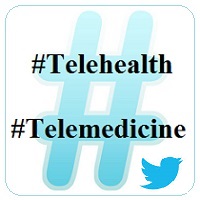 Stay up to date on the latest and join the conversation with #Telehealth and #Telemedicine.
Stay up to date on the latest and join the conversation with #Telehealth and #Telemedicine.
More and more hospitals are seeking to integrate telemedicine into their programs. Some are doing it well, while some seem to be jumping the gun and not getting it right. In April, a panel of experts at the Becker’s Hospital Review 7th Annual Meeting in Chicago discussed barriers, boons and the general state of telemedicine integration for hospitals. They came away with six important take aways for any large health system planning to incorporate telemedicine.
TeleHealth Services Shares Research to Optimize Patient Interactive Education and Engagement
It seems everyone these days, from grandparents to grandchildren, is technologically inclined. We utilize or encounter technology in quite a few areas of our daily lives. Healthcare providers are starting to recognize the value of using information technology to help their patients with their own care to improve outcomes and lower costs. TeleHealth Services (@TIGREddie), the nation’s leading provider of interactive patient engagement solutions, is sharing research and perspectives based on almost two decades of experience in the interactive patient engagement marketplace with a new white paper, “Impacting Successful Outcomes: Optimizing Patient Interactive Education and Engagement.”
Teledoc bids $125 million for HealthiestYou
Teladoc (@Teladoc), the first and largest telehealth platform in the United States recently announced that it has agreed to acquire HealthiestYou (@Healthiest_You), a leader in mobile patient engagement, based in Scottsdale, Arizona. “This is a unique opportunity to combine two leaders in the telehealth industry who share a common philosophy of driving telemedicine engagement and enabling consumers to take charge of their own health care decisions,” said Teledoc CEO Jason Gorevicr.
Telemedicine Companies See Mental Health As Next Frontier
Mental health conditions are on the rise in America. These days more people suffer from mental health conditions than medical conditions like diabetes and heart disease. Companies such as MDLive (@MDLIVEInc), Teladoc and American Well (@AmericanWell) have taken notice of this huge growth opportunity and are getting into the business of offering access to psychiatrists, psychologists and therapists via smartphone, tablet and computer.
What’s up, doc? Tell me over my smartphone, please
More and more patients are seeking virtual health consultations through video, text or email. Parks Associates, a market researcher, says 5.7m doctor-patient video consultations took place in the US in 2014 and that number was expected to reach 16m in 2015. Companies such as HealthTap (@HealthTap), Teledoc, and AmericanWell are happily providing services to satisfy patient requests. In the US, one of the world’s most expensive markets for medical care, telemedicine providers estimate that savings can range from $200 to $700 per patient visit. For patients, prices start at $9.99 for a medical question posed to a doctor.
Office Chatter: Your Doctor Will See You In This Telemedicine Kiosk
Telemedicine coverage is making its way little by little into the realm of insurance coverage. Employers are seeing the benefits of offering telemedicine services to their employees and telemedicine kiosks are popping up in office buildings around the country. “Employers and insurers see the kiosks as a pathway to delivering quality care, reducing lost productivity due to time spent traveling and waiting for care, and saving money by avoiding costlier visits to emergency rooms and urgent care facilities.” American Well and Computerized Screening, Inc., two telemedicine companies who offer kiosks, say employees often pay either nothing or no more than $15 per session, far less than they would pay with insurance at a doctor’s office, an urgent care clinic or an emergency room.
In State News
USDA Announces Telemedicine Funding to Address Opioid Epidemic in Appalachia
In order to help address the opiod crisis in rural America, USDA has announced five Distance Learning and Telemedicine (DLT) grant awards to help provide treatment for the growing epidemic in rural central Appalachia. The announcement was the first in a series of DLT projects that are to be announced this summer which include nearly $1.4 million for five projects in Kentucky, Tennessee and Virginia to help rural areas address the opioid epidemic. “Because addiction treatment is often out of reach for many in rural America, expanding access to telemedicine is an important step towards making sure rural communities have the tools they need to fight the opioid epidemic,” said Agriculture Secretary Tom Vilsack.
Telerehab Now Covered Under Minnesota Medicaid
The Minnesota Department of Human Services has expanded Medicaid coverage to include telerehab. Lawmakers approved reimbursement for telerehab services provided by speech-language pathologists/assistants, physical therapists/assistants, occupational therapists/assistants, and audiologists over a secure, encrypted channel. To qualify for reimbursement, health providers must meet all the conditions of the Minnesota Health Care Programs (MHCP) telemedicine policy.
Louisiana’s New Telemedicine Law Opens Doors, Removes Barriers
Louisiana’s New #Telemedicine Law Opens Doors, Removes Barriers https://t.co/aQNfSLUo7o @AmericanTelemed pic.twitter.com/3RbkfBe2Ti
— Nathaniel Lacktman (@Lacktman) June 30, 2016
Global Telemedicine Market Outlook 2022
Research and Markets, the world’s largest research store recently issued a new research report “Global Telemedicine Market Outlook 2022.” According to the report, the market for telemedicine is anticipated to grow at a CAGR of approximately 19% during 2015-2022. In 2015 the telemedicine market was valued at US$ 21 Billion. The growth of the market is likely to be driven by increasing adoption of telemedicine, rising incidences of chronic diseases, growing geriatric population, government initiatives, and shortage of physicians amongst others.
